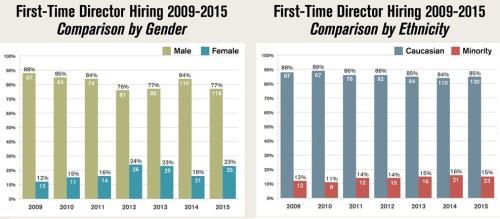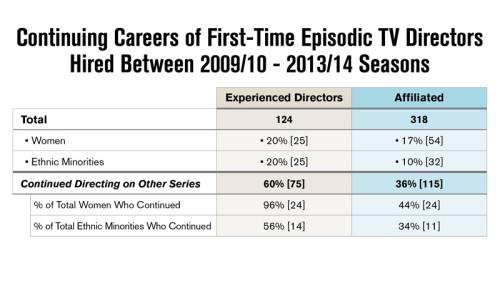Women And People Of Color Overlooked For Critical First Breaks In TV Directing

When white men maintain the majority of power in an industry they also inherently have the power to decide who gets their first big break.
More often than not, these critical first breaks are offered to other white men. This trend is apparent in the film industry according to a new study released by the Directors Guild of America (DGA). The new study, “Women and Ethnic Minorities Continue to be Overlooked for Critical First Breaks in Television Directing,” examined gender and race in conjunction with who was more likely to catch their first-break directing television and film, from 2009 onwards to 2016.
Two main conclusions were collected from the study regarding which first-time TV directors get hired the most – women have slightly gained over the past few years, hiring people of color has remained stagnant.

Images: Directors Guild of America
The study measured data from 2009-2010 to 2015-2016 mapping the breaks and progress of first-time directors. Within the past 2015-2016 season, 153 directors were hired for the first time whether by studios, networks, or executive producers. Out of the 153 directors, 15% were people of color and 23% were women. As shown above, through each season numbers fluctuated with first-time female directors increasing after a previous fall, and a flat rate among hiring new directors of color.
“If they were serious about inclusion, they would commit to do two simple things,” said Bethany Rooney, co-chair of the DGA Diversity Task Force. “First, look around and see that there’s already a sizable group of experienced women and minority directors ready to work and poised for success – and they would hire them. And second, they would more carefully consider these first-time directing jobs, and – with an eye toward director career development. In the end it’s all about who is a good director.”
The study also measured the long term impact of directors receiving their first break. For every industry networking is key, yet for a majority like film, the networks are exclusive and typically dominated by one group. When following first-time directors hired between 2009 and 2014 seasons, a majority of them went on to continue and develop more film in and outside of the original series they were hired for. Within the group, 26% became experienced directors while 66% became affiliated hires.

Image: Directors Guild of America
Those like Ava DuVernay know the power of getting your first break. It was megastar Shonda Rhimes who gave DuVernay her first TV job in 2013 directing an episode of ABC’s Scandal. After the initial break, DuVernay’s career quickly sped up. “I know what one episode of television can do for someone who hasn’t had it before,” says DuVernay for The Hollywood Reporter. “Television is where I’m seeing brave storytelling – the most inclusive storytelling,” she says.
The data shows, as mirrored beautifully in Ava DuVernay’s career, that out of these premiere, experienced directors, women and people of color are even more likely to reach greater success in their film careers. Results shared that 96% of women and 56% of people of color continued to direct further series, compared with those who had only become affiliated hires.
With this in mind, DuVernay went full force displaying the power of first breaks with Queen Sugar, her new drama on OWN, staffed entirely by female directors. One season in and the directors behind Queen Sugar have already established their mark in film with six of their directors landing outside TV gigs.
“People tell me this show — a female-led and minority-led show, on camera, behind the camera and in the writers room — is a unicorn,” shares Queen Sugar director Tina Mabry, But for me, the goal now is that this not be a unicorn. Let’s tear off the damn horn and make it a horse.”
This past November countless women in film covered The New York Times Magazine in “The Women of Hollywood Speak Out,” where they revealed the grave disparities of women and people of color in film – behind and on the screen. We read of the unbelievable statistics – In 2013 and 2014 only 1.9 percent of 100 of the top-grossing movies were directed by women and between 2007 and 2014 out of 30,835 parts just 30.2 percent of all speaking roles were acted by women.
The New York Times continued to share reflections and experiences of women and people of color in film in pieces like, “What It’s Really Like to Work in Hollywood* (*If you’re not a straight white man.)” and “Asian-American Actors Are Fighting for Visibility. They Will Not Be Ignored.” These pieces allowed us to learn how underrepresented these groups and their experiences are often marginalized, left out, and incredibly pigeonholed by physical appearance. The inequality in film only worsened after Oscar nominations were released in January with zero Black actors nominated quickly coining the term, #OscarsSoWhite.
Aziz Ansari on acting, race and Hollywood https://t.co/mkHYRbHtIf@azizansaripic.twitter.com/twn046JGUd
— The New York Times (@nytimes) November 10, 2015
From the aftermath, The Academy of Motion Picture Arts and Sciences attempted to debunk the controversy in June by inviting a record number of new members, 683 within the group 46 percent are women and 41 percent are people of color. Not only did many take the new act as faulted, but with the 683 new invites the Academy would only change from 75 to 72 percent male and from 92 to 89 percent white, in sum a population change of 3 percent.
The goal now is to replicate what works – no excuses. No “handouts” or diversity pleas are necessary as groups of hungry directors are only waiting to get their opportunity to shine and streamline their greatness. With heavy hitters like Shonda Rhimes, Aziz Ansari, and Ava DuVernay making a stance through the creation of their own projects, they are delivering opportunities outside of the white male network. Only this way can disparities in film ever be truly broken down.





